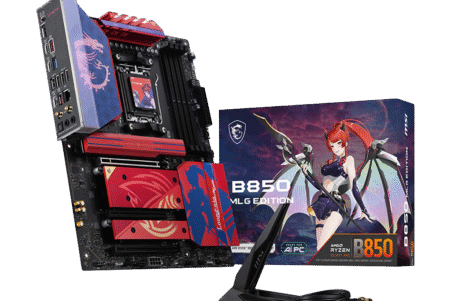At around 64.6 g (measured with the USB dongle installed), the MSI Versa 300 Elite Wireless lands squarely in that ultra-lightweight class of gaming mice. That weight is confirmed by manufacturer specs citing 65 g for the body.
Holding it, the balance feels surprisingly stable; you don’t get that “front-heavy” tip you sometimes see in featherweight mice. Its symmetrical, slim design makes it friendly to users who are either left-handed or right-handed. The sides are surfaced with MSI’s “Diamond Lightgrips” which is a subtle textured anti-slip finish that gives you grip without feeling abrasive.
Build-wise, it feels solid. The buttons have no noticeable flex, and the shell resists minor flexing under firm grip pressure. The PTFE glides are smooth and low friction. What can I say, it’s a well-made mouse for its price point.
Performance & Sensor Behavior


I put it through its paces in competitive shooters, fast-paced MOBAs, and even productivity workflows. What stood out:
Polling Rate & Latency
The mouse delivers a true 1,000 Hz polling rate (1 ms), consistent with what MSI advertises. In wired mode, the input feel is crisp and near instant. In wireless (2.4 GHz, “SWIFTSPEED”) I noticed no perceptible lag in 99% of cases, though in a few sharp flicks I suspect you might notice micro-jitter under extreme input strain. That is only if you focus your entire attention on it and try to look for it. Though MSI promises “1 ms latency,” and in practice it holds up well from the testing I did.
DPI & Tracking
Out of the box, the Versa 300 Elite is preset to DPI steps of 400 / 800 / 1600 / 3200 / 6400. To unlock higher values (e.g. up to 26,000), you need MSI Center (software) support. Once unlocked, the PixArt PAW3395DM sensor is precise, responsive, and handles fast swipes without stuttering or “jumps.” For most gamers, the standard DPI steps are plenty, but having headroom via software is a smart fallback.
In my tracking tests across a variety of mousepads and surfaces, the cursor stayed true; no wild spinouts or tilt correction issues. The sensor does well even at higher speeds.
Connectivity Modes
One of this mouse’s strengths is flexibility: you can use wired (via USB-C cable), 2.4 GHz wireless, or Bluetooth 5.3 all built into one device. For serious gaming, wired is still the gold standard (lowest latency, zero interference). In daily use (e.g. switching between laptop and desktop), the wireless modes are convenient.
Battery life is rated up to 200 hours (full charge) in optimal conditions (though I have not tested the battery life, I did manage to go few days without charging it). In practice, expect that to drop under heavy use, RGB on full brightness, or frequent wireless toggles but I easily got several full sessions without recharge.
Switch durability is also respectable: Omron microswitches rated for 60 million clicks.
User Experience & Real-World Use


Across a week of mixed gameplay (FPS, RTS, MMO) and general productivity, the Versa 300 Elite rarely felt like a compromise.
It’s very light and comfortable and I quickly forgot that I was holding it during long sessions. Its ambidextrous shape doesn’t overly favor a specific grip, which is a plus for those who rotate between grip styles (palm, claw, fingertip).
Transitions between connectivity modes are seamless. For instance, I kept it in wired mode during full gaming sessions, then switched to Bluetooth for light browsing or mobile work no major hiccups.
That said, the scroll wheel remains a small gripe. The textured bumps are helpful for tactile feedback, but they press uncomfortably into your finger pad during rapid scrolling. After some time you adapt, but it never becomes “perfect.” And because there’s no infinite scroll or smooth scroll toggle, you can’t instantly switch between coarse and smooth scroll depending on your workflow (e.g. weapon switching vs document scroll). That would have elevated the usability further.
Another minor thing: if you don’t install or use MSI Center, the DPI ceiling is limited to 6400 (preset steps). Some users may prefer not to run extra software; without it, the higher settings remain inaccessible.
In terms of price: official MSRP is $70, though street deals (especially on Amazon) bring it down to around $50 when timed right. That gives it strong value, considering its specs and features. (Amazon listing currently shows $46.61 among top retailers, at the time of writing this)
I compared this intuitively with competitors in the same class (ultralight wireless mice), and the Versa 300 Elite holds up well sometimes surpassing rivals in ergonomics or flexibility, though not always in top-tier sensor specs it still performs to a high standard.
MSI Latest Series: MLG


When researching about this mouse to ensure I am being fair, I notice there is the latest MSI latest series which is the MLG. My wife and I love anime (to some extent), and because her computer and gears needs a major upgrade I decide, to slowly by parts of MLG to build it up.
The mouse despite the name different is exactly like the Versa 300 Elite. Though it is $80, I believe it was worth the price. It features a nice red aesthetic and Loong:Nia (that is the name of the anime girl you see in the image) logo and the feel of comfortability is exactly the same .
That is how confident I am with the gaming mouse. Though still the MSI Center have long ways to go and hoping that they will put more dedication and time to the software to make the experience more enjoyable for all, I can say this is solid gear to have when you either game or work.






